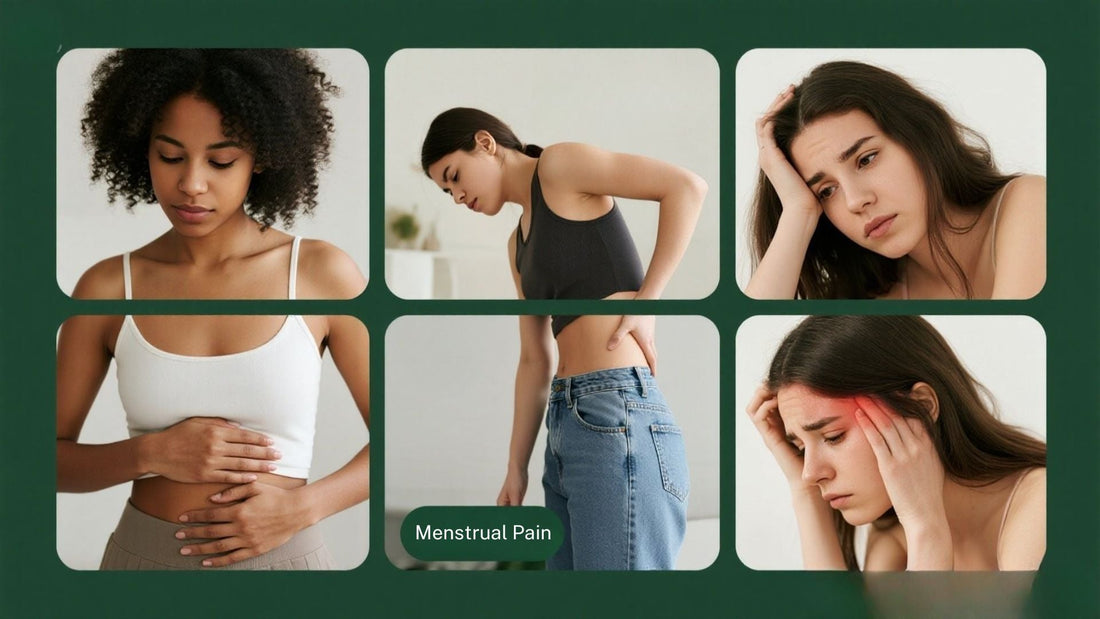
Understanding the Different Types of Menstrual Pain and What They Mean for Your Health
Share
The Characteristics of Period Pain: Sharp, Dull, Throbbing
Menstrual cramps affect millions of people worldwide, yet all too frequently are minimized as "just part of having a period." The truth is that period pain can be highly heterogeneous with regard to severity, length, and cause. Some individuals have minimal cramps that resolve relatively easily, while others experience significant pain that interferes with daily activities.
Knowing the types of menstrual cramping helps you understand what is normal and what could be a sign of a medical condition. Knowing the pain types: cramping, lower abdomen pain, or referred pain—you can more effectively manage symptoms and recognize when to visit a physician.
Primary vs. Secondary Dysmenorrhea: The Two Main Types of Menstrual Pain
When physicians speak about menstrual cramps, they most often mean dysmenorrhea, the medical name for cramping menstruation. Dysmenorrhea can be separated into two categories:
Primary Dysmenorrhea
- Definition: Discomfort due to regular uterine contractions with menstruation.
- When It Happens: Typically starts during adolescence and can decrease after age or delivery.
- Symptoms: Cramping in the lower abdomen, pressure in the pelvis, pain that spreads to the lower back and thighs, headaches, or nausea.
- The leading cause of primary dysmenorrhea is prostaglandins, hormone-like chemicals that cause uterine contractions. Excess prostaglandins are associated with more severe cramps.

Secondary Dysmenorrhea
- Definition: Pain that is caused by an underlying reproductive tract disease.
- When It Happens: Often begins later in life and worsens.
- Symptoms: Worse pain, which may start before menstruation and continues after menstruation.
Some of the more common reasons for secondary dysmenorrhea include:
- Endometriosis – Cells resembling the endometrium develop outside the uterus.
- Adenomyosis – The uterine lining grows into the muscle layer of the uterus.
- Fibroids – Benign growths which may lead to overbleeding and cramping.
- Pelvic Inflammatory Disease (PID) – Infection of the reproductive organs.
If your menstrual cramp increases or fail to subside with over-the-counter medications, secondary dysmenorrhea is likely to be the cause.
Other Types of Menstrual Pain Beyond Cramps
Menstrual pain isn’t limited to cramping. Many people experience other types of discomfort that can affect multiple areas of the body.
Lower Back Pain
Some individuals experience sharp or dull aches in the lower back during menstruation. This occurs because uterine contractions can radiate through the pelvic nerves to the back.
Tip for relief: Gentle yoga stretches or applying a warm compress can ease tension in the lower spine.
Gastrointestinal Discomfort
Hormonal changes during your period can impact digestion, leading to:
- Bloating
- Diarrhea
- Constipation
- Stomach upset
These issues are also linked to prostaglandins, which affect not only the uterus but also the intestines.
Headaches and Migraines
A drop in estrogen before menstruation can trigger headaches or menstrual migraines. These can be mild or severe, sometimes requiring medication to manage.
Generalized Fatigue and Body Aches
Fluctuations in hormones and blood loss can contribute to overall tiredness and soreness. This type of pain may not feel like sharp cramps but it still has a significant impact on daily functioning.

Recognizing When Menstrual Pain Is Not Normal
While mild cramping is common, there are times when period pain could point to a deeper issue. Warning signs include:
- Pain that disrupts work, school, or sleep.
- Heavy bleeding with large clots.
- Pain that worsens with age.
- Persistent pain even outside your menstrual cycle.
If you experience these symptoms, it’s worth consulting a healthcare provider for further evaluation. Early detection of conditions like endometriosis or fibroids can make treatment more effective.
Practical Tips to Manage Different Types of Menstrual Pain
Fortunately, there are many ways to reduce discomfort, from lifestyle changes to natural remedies. Here are some proven approaches:
-
Heat Therapy- Applying a heating pad or warm water bottle to the lower abdomen helps relax uterine muscles and improve blood flow.
-
Regular Exercise- Low-impact activities like walking, yoga, or swimming release endorphins that act as natural painkillers.
-
Dietary Adjustments
-
- Increase foods rich in omega-3 fatty acids (like salmon or flaxseeds) to reduce inflammation.
- Reduce caffeine and salt intake to minimize bloating.
- Stay hydrated to ease bloating and fatigue.
-
Natural Supplements - Some people find relief with magnesium, vitamin B6, or herbal teas like ginger and chamomile. Always consult a healthcare provider before starting new supplements.
-
Stress Reduction Techniques - Deep breathing, meditation, and mindfulness practices can reduce stress, which may worsen pain perception.
-
Over-the-Counter Medications - NSAIDs like ibuprofen can reduce prostaglandin levels and ease cramps, but should be taken as directed.

Living Well With Menstrual Pain: A Balanced Approach
Managing menstrual pain often requires a combination of strategies. For example, you might combine dietary adjustments with stress relief techniques and keep a heating pad handy for flare-ups.
It can also help to track your symptoms. Using a period-tracking app or journal allows you to notice patterns and identify which strategies work best for you. Sharing this information with your doctor can also provide valuable insights if you need medical support.
Understanding Your Body, Taking Control of Your Period
Menstrual pain comes in many forms, from common uterine cramps to secondary conditions like endometriosis or fibroids. Recognizing the types of menstrual pain you’re experiencing is the first step toward effective management.
While mild cramping can be addressed with lifestyle changes, more severe or persistent pain should never be ignored. Your body communicates through symptoms, and listening to these signals can make a big difference in your overall health.
If period pain affects your quality of life, take action—whether by trying natural remedies, making dietary adjustments, or seeking medical advice. You don’t have to suffer in silence, and relief is possible with the right approach.



